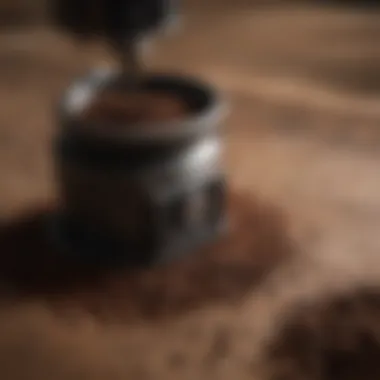Best Coffee Grinders Under $150: A Comprehensive Guide


Intro
Selecting the right coffee grinder can make all the difference between a mundane cup of coffee and an extraordinary brewing experience. With the booming popularity of specialty coffee, there’s a growing awareness of how the grinder's capabilities can affect flavor profiling. Finding a suitable coffee grinder without breaking the bank is crucial, especially for those who crave quality but are working within a budget of $150.
Understanding your options and the features that matter most can be overwhelming; with so many models on the market, how does one sift through the noise? This guide is tailored to distill this complexity into digestible insights that cater to both novice coffee drinkers and more discerning aficionados. We'll explore grinder types, critical buying criteria, and some standout models that can elevate your morning ritual without emptying your wallet.
Key insights from current trends in coffee culture also shed light on the choices consumers make today. Different types of grinders can yield different flavor profiles, and recognizing this can guide you toward the best choice tailored to your unique palate.
In the coming sections, we’ll breakdown key features to look for, highlight popular models available in this price range, and offer maintenance tips to prolong the life of your grinder. Whether it’s the perfect espresso shot or a robust pour-over, knowing what your grinder contributes to the process is essential. So, buckle up, as we embark on a journey into the world of coffee grinding!
Understanding Coffee Grinders
When it comes to brewing a good cup of coffee, many enthusiasts often overlook one crucial tool: the coffee grinder. Understanding this device is paramount for anyone looking to elevate their coffee experience without breaking the bank. Coffee grinders serve a vital role in the extraction process; they dictate the particle size of the coffee grounds, which directly influences the flavor and aroma of the final brew. A good grinder will provide a consistent grind size, ensuring that water extracts the flavors evenly, while a subpar option can lead to an imbalanced cup.
In this segment, we will explore the intricate relationships between the type of grinder used and the brewing method employed, as well as various options available on the market today. Having a good grasp on these factors will help you make informed decisions as you venture into purchasing a coffee grinder within the $150 budget.
The Role of Coffee Grinders in Brewing
Coffee grinders are the unsung heroes of the brewing process. Even the most expensive beans can taste lackluster if the grind isn’t right. Why? Because once coffee beans are ground, they are exposed to air, moisture, and light, which can prematurely degrade their flavor compounds. By grinding the beans just before brewing, you preserve their freshness and fullest flavor profile.
Furthermore, the right grind size for the brewing method you choose makes all the difference. For instance, a fine grind is essential for espresso, while a coarse grind works best for methods like French press. Understanding these dynamics aids in crafting the perfect cup tailored to your preferences.
Types of Coffee Grinders
There are primarily two types of coffee grinders: blade grinders and burr grinders. Each has its own characteristics, benefits, and drawbacks.
Blade Grinders
Blade grinders are often the entry-level option for many home brewers. They operate using a spinning blade that chops the beans into smaller pieces. This can be a quick solution for someone just starting out with coffee.
One key characteristic of blade grinders is their affordability and compact design. They are widely available and do not occupy much counter space, which makes them more accessible for the average consumer. However, their primary drawback is grind consistency. Since the blades chop indiscriminately, you’re likely to end up with a mix of coarse and fine particles, leading to uneven extraction when brewed.
A unique feature of blade grinders is their speed; they can grind coffee quickly – perfect for those in a hurry. On the flip side, users might find that they can get better flavor profiles with a more consistent grind size than these grinders can offer.
Burr Grinders
Burr grinders are considered the gold standard in the coffee community. They grind beans between two abrasive surfaces, allowing for a more uniform particle size. This factor alone can drastically improve your brewing results.
A notable characteristic of burr grinders is the ability to adjust the grind size more precisely. They come in two main types: flat burr and conical burr, both of which can provide optimal grind consistency. Many find burr grinders to be a solid investment; while they may be pricier upfront, they contribute to a superior coffee experience over time.
Furthermore, an advantage of burr grinders is that they usually produce less heat during grinding. Heat can alter the flavor of the coffee by burning the grounds, so this is an important consideration. Their disadvantages include a higher price point compared to blade grinders, but the trade-off in flavor quality and consistency often justifies the extra cost for dedicated coffee drinkers.
In summary, understanding the various types of coffee grinders enables you to make a thoughtful choice in your journey toward achieving that perfect cup at home.
Criteria for Choosing the Right Coffee Grinder
Selecting the right coffee grinder is pivotal for any coffee lover aiming to brew a top-notch cup of joe. You might be thinking, "Why not just pick any grinder?" Well, that’s like expecting a fine wine from a plastic bottle. The right grinder can significantly influence your brewing results, unlocking the full potential of your beans. The criteria we’ll explore encompass fundamental aspects like budget, grind size consistency, ease of use and maintenance, as well as size and capacity. By grasping these factors, you’ll make a choice that sings to your coffee needs without making your wallet groan.


Budget Considerations
When it comes to choosing a coffee grinder, money often talks. A budget of $150 is a wealth of options, yet it’s essential to remember that not every grinder in this range will deliver the goods. Here are some key points to ponder:
- Evaluate Your Spending Power: Determine how much you're willing to part with. It’s one thing to have $150, but what you choose reflects your coffee-loving personality.
- Weight Performance Against Price: A grinder at this price might come with necessary features yet may lack luxury. Seek one that offers the most bang for your buck. Consider the models that bring in components offering durability and consistency without pushing the total beyond your budget.
- Long-Term Investment: Sometimes, spending a touch more makes sense down the line if it avoids the cheaper models breaking you’ve needlessly switched out. Be mindful of the long game.
Grind Size Consistency
The magic of coffee is in its nuances, and grind size consistency is a cornerstone of that. Uneven grinds can lead to over-extraction or under-extraction, which results in a brew that tastes off.
- Why Consistency Matters: Studies suggest that consistent grind particles lead to optimal flavor extraction. Imagine brewing a lovely batch only to taste bitterness because some grounds overcooked while others remained underdone.
- Types of Grinders: Burr grinders generally provide superior consistency compared to blade grinders. They crush coffee to uniform sizes whereas blade grinders chop unevenly. While both types exist within your budget, burr grinders tend to yield better results.
Ease of Use and Maintenance
The thrill of brewing coffee should never feel like a chore. Therefore, ease of use and maintenance plays a critical role in your choice of grinder.
- User-Friendly Features: Look for simple controls. Some models come with one-touch operations, allowing you to grind and go.
- Cleaning Challenges: A grinder that’s a headache to clean will quickly become a counter hog. Grinders with removable parts ease the cleaning process. Look for those labeled dishwasher safe.
- Durability: Invest in a grinder that is built to last. Read reviews that mention long-term reliability or materials used.
Size and Capacity
You’ll want to know how much coffee you regularly brew since this will guide which grinder fits your needs best.
- Counter Space: Be conscious of how much room you’re willing to spare on your countertop. Some grinders can be substantial and eat up space, while others come compact.
- Capacity: If you often brew several cups at once or love inviting friends over for coffee tasting, a larger capacity grinder might suit you. However, if you brew for yourself, a smaller model may work just fine without taking up too much space.
Best of luck on your quest for the perfect grinder! Keeping these criteria in mind will surely set you on the path to finding a quality device that enhances your coffee experience.
Best Coffee Grinders Under
When considering the best coffee grinders under $150, it’s important to balance quality and budget. Many coffee aficionados believe that the grind is as essential as the beans themselves. The right grinder can significantly enhance the flavor profile of your brew, making this segment crucial. Within this price range, a plethora of options caters to various preferences and brewing methods. Each model brings its unique set of features, benefits, and considerations, allowing consumers to make informed decisions.
Top Recommended Models
Model One Review
One standout choice is the Breville BCG820BSSXL The Smart Grinder Pro. Known for its versatility, this grinder offers an impressive range of grind settings, making it suitable for everything from espresso to French press.
The key characteristic of this model is its digital timer, allowing users to achieve consistent grind times. Users rave about the quality of the coffee produced thanks to this feature, as it ensures repeatable results each time. A unique feature is the stainless steel conical burrs, which not only enhance durability but also produce a uniform grind size. While this grinder is a favorite, it does have a slightly larger footprint that may not suit all kitchen spaces.
Model Two Review
Next up is the Baratza Encore Conical Burr Coffee Grinder, often seen as a stepping stone for serious coffee enthusiasts. Its ease of use is one of its most appealing aspects.
This model shines with its simplicity, making it beneficial for those new to grinding their own coffee. The key characteristic here is its 40 grind settings, which provide flexibility for different brewing methods. A hallmark feature is the user-friendly design; it’s mostly fuss-free, which is great for busy mornings. However, it might lack some advanced features found in higher-end models, such as a built-in scale, which could be a drawback for those seeking precision.
Model Three Review
Finally, there’s the Capresso 560.01 Infinity Conical Burr Grinder. This model appeals to those looking for a reliable and affordable option.
The standout feature of the Capresso Infinity is its gear reduction motor. This provides slower grinding, minimizing heat buildup, and preserving the beans’ natural oils. It has a decent range of settings, which lets users fine-tune their grind for their preferred brew style. Despite this, some users note the grinding speed can be slow, which might frustrate those keen on quick brewing.


Comparison of Features
When evaluating these models, some key features stand out:
- Grind Size Settings:
- Timer and Ease of Use:
- Build Quality and Design:
- Breville: 60 settings give vast flexibility.
- Baratza: 40 settings, easy but still versatile.
- Capresso: 16 settings, limited but sufficient for basic needs.
- Breville: Digital timer aids in consistency.
- Baratza: Simple operation, user-friendly.
- Capresso: Easy to operate but lacks advanced options.
- Breville: Sturdy with stainless steel burrs.
- Baratza: Durable, yet sleek and compact.
- Capresso: Solid construction, practical but less stylish.
Exploring Grind Sizes and Their Influence on Flavor
When it comes to brewing that perfect cup of coffee, the grind size might just be the most significant factor often overlooked. Coffee grind size isn't merely about aesthetic or convenience; it plays a pivotal role in extracting flavor. The relationship between grind size and flavor varies greatly, depending on the brewing method you choose. By understanding these nuances, you're one step closer to elevating your coffee experience, particularly when you’re looking at options under $150.
Coarse vs. Fine Grinds
The distinction between coarse and fine grinds hinges on surface area and extraction rate. Coarse grinds typically measure around the size of sea salt, while fine grinds resemble granulated sugar. Now, why does this even matter? Think of it as a delicate balancing act.
A coarser grind allows for a slower extraction, releasing flavors more gradually, which is essential for brewing methods like French press or cold brew.
Conversely, a finer grind, ideal for espresso machines or AeroPress, creates a larger surface area. This can lead to quicker extraction, enhancing the intensity and richness of the brew.
It's crucial to match grind size with your chosen brewing equipment. If the grind is too coarse for a method that requires finely ground coffee, you might end up with weak, bland coffee. On the opposite end, if your grind is too fine, the brew can become bitter, causing an unpleasant experience.
Here’s a quick look at the relationship:
- Coarse Grinds: Better for methods that require longer brewing times; produces smooth, flavorful results.
- Fine Grinds: Ideal for fast extraction methods; usually yields bold and complex flavors.
"The right grind can be like having your cake and eating it too; it’s not just about the size, but how it changes the flavor profile."
Impact on Brewing Methods
The grind size affects brewing methods in that each method has an optimal consistency to achieve a satisfying cup. Let’s break down how different methods respond to grind sizes:
- French Press: It calls for a coarse grind. In this instance, the coffee grounds steep in hot water, and a coarser grind helps avoid over-extraction, which can lead to bitterness.
- Espresso: This method thrives on fine grinds. The high pressure used during brewing demands quick extraction, which a fine grind easily accommodates.
- Pour Over: This strikes a betweeen those two. Generally, a medium grind works well here. It balances extraction rates, giving that lovely clarity and sweetness we crave in pour-over coffee.
- Cold Brew: A coarse grind is a must. The long steeping time requires a gentle extraction to keep undesirable bitterness at bay while allowing sweeter notes to shine.
Understanding these factors can drastically refine one’s coffee-making process. By paying attention to the grind size, consumers can hone in on flavor profiles they desire, whether it's a spicy kick or chocolatey sweetness. It becomes more than mere coffee—it's a carefully crafted experience.
Maintenance and Care of Coffee Grinders
Maintaining a coffee grinder is not merely a task; it��’s an investment in quality, a way to ensure that every cup brewed is as fresh and flavorful as possible. Without proper care, a grinder can become a breeding ground for stale coffee oils and uneven grinds, ultimately tampering with that carefully crafted brew you enjoy.
Regular maintenance protocols extend the lifespan of the grinder and its ability to produce a consistent grind size. This maintenance involves two primary components: cleaning and storing your grinder properly. Ignoring daily or weekly upkeep might not seem catastrophic immediately, but over time, it can lead to build-up that affects not just taste but performance. Likewise, how you store your grinder can influence its longevity and effectiveness.
In summary, committing to consistent maintenance allows you to enjoy your coffee at its best while protecting your equipment. Let’s break this down further with a more detailed approach.


Cleaning Steps
- Unplug the Grinder: Always ensure the grinder is disconnected from the power source before starting any cleaning process. Safety first.
- Remove the Bean Hopper: Most grinders will have a removable hopper that can be easily detached. Take this off and give it a gentle rinse with warm, soapy water. Make sure it’s fully dry before reattaching.
- Brush Out Residue: Use a small brush (often included with your grinder) to sweep away any ground coffee trapped in the grinding chamber. Pay extra attention to the burrs or blades, as this area tends to retain oils and grounds.
- Wipe Down Exterior: A damp cloth is helpful here. Wipe down the exterior of the grinder, which can accumulate dust and stains over time.
- Deep Cleaning: For those who grind regularly, consider a deep cleaning monthly. This involves using rice or a grinding cleaner designed for this purpose. It helps absorb the oils that can linger.
Follow these steps regularly to maintain grinder hygiene.
Storage Recommendations
Proper storage of your coffee grinder can greatly affect its performance. Here’s how:
- Cool, Dry Place: Store your grinder away from heat sources and moisture. Excessive humidity can harm the electronic components and create a perfect environment for rust.
- Avoid Direct Sunlight: Keeping your grinder in a well-lit, sunny spot might be tempting, but prolonged exposure can degrade materials and affect its aesthetics.
- Use a Cover: If possible, using a cover or bag to encase the grinder can provide additional protection against dust.
- Don’t Store Coffee Beans in the Grinder: Even if the grinder has a sealed compartment, it’s best practice to keep the beans in an airtight container elsewhere. This avoids exposure to air, light, and moisture.
Adhering to these storage considerations will ensure that your coffee grinder stays in tip-top shape while contributing to the quality and freshness of your coffee. Overall, your vigilant efforts in maintaining and storing your grinder set the stage for an exceptional coffee brewing experience.
User Preferences and Specialized Needs
When it comes to brewing coffee, a one-size-fits-all approach rarely works. For many, the quest for the perfect cup revolves around personal taste and preferred brewing methods, making user preferences and specialized needs a pivotal aspect of selecting a coffee grinder. Understanding these preferences can influence not only the type of grinder chosen but also its performance and the overall coffee experience that follows.
For Espresso Enthusiasts
Espresso aficionados often advocate for finer grind sizes, as these are essential for creating the rich, concentrated flavors characteristic of this brewing method. The grind needs to be uniform to avoid channeling, where water finds paths of least resistance, leading to uneven extraction and ultimately, a subpar shot of espresso.
To meet the specific needs of espresso lovers, a burr grinder is generally the way to go. Burr grinders, particularly flat burr types, provide that consistent grain size that enthusiasts crave. They also allow for micro-adjustments, giving users the flexibility to tweak grind settings based on the beans' freshness or even the weather—a significant factor affecting brewing since humidity can swell coffee grounds, affecting extraction.
It's important for espresso lovers to prioritize grind size precision and dosing consistency. Some models even offer weight-based dosing, measuring each dose accurately and ensuring that every shot served maintains quality. Brands like Baratza and Breville stand out here, touted for their high level of calibration and durability. For them, brewing isn't just a habit; it's an art, and the grinder is a key tool in this creative endeavor.
For French Press Lovers
On the flip-side, French press lovers appreciate a coarser grind, a delightful nod to the method's straightforward character. The coarse grind allows for steeping, which brings out those groovy, full-bodied flavors without the bitterness that a finer grind might introduce. The pressing action is also where grind size plays a role; if the grind is too fine, it could lead to a mucky cup filled with sediment, detracting from the rich experience.
When selecting a grinder for French press, one should look for a model that can deliver coarser settings conveniently. Conical burr grinders are particularly favored, as they tend to produce less heat during grinding and maintain the coffee's essential oils and aromas. Brands like Hario and Capresso have made a mark with their user-friendly models that deliver on performance and aesthetics.
Additionally, users should consider capacity; a larger grind chamber can save time in the mornings, especially for those who entertain guests often. The ease of cleaning and maintenance is also a valuable factor. French press enthusiasts may value a grinder that doesn't only get the job done but also integrates smoothly into their kitchen aesthetic and routine.
Selecting the right coffee grinder based on your brewing method and personal preferences is more than just functionality; it’s about enhancing the sensory experience that coffee provides.
The End
As we wrap our exploration into the world of coffee grinders under $150, it's crucial to reflect on the key insights shared throughout this guide. It’s not merely about finding a device to grind your beans. Instead, it’s about enhancing the overall brewing experience, nudging you closer to that perfect cup of coffee each morning. The right grinder can significantly impact flavor extraction, which is a vital consideration for anyone who takes their coffee seriously.
In this article, we emphasized several essential elements that influence your buying decision. Factors such as grind size consistency and ease of use are paramount. For instance, if you're an espresso lover, you'll need a grinder that can provide ultra-fine grinds. Conversely, those who enjoy French press will benefit from coarser settings. Understanding these subtleties can not only influence the flavor profile of your brew but also elevate your barista skills.
The importance of budget cannot be overstated. Finding a reliable coffee grinder that meets your needs without breaking the bank is entirely possible within the $150 range. Many high-quality models come with features that rival more expensive machines, offering great value. You shouldn’t have to sacrifice quality for affordability.
"The best coffee is a blend of art and science. Great tools can make a notable difference."
Moreover, maintenance and ease of cleaning affect the longevity of your grinder and the quality of the coffee you brew. Simple upkeep steps can ensure your equipment remains in prime condition. In addition, understanding the specific needs related to your brewing method—not just your personal taste—comes into play when making a choice.
Finally, this guide doesn't aim to push specific brands or models but encourages readers to reflect on their individual preferences and brewing methods. Personalization is key in the quest for the optimal coffee experience. The ultimate goal is to empower homeowners, enthusiasts, and party hosts alike with informed choices, fostering an appreciation for the rich craft of coffee brewing.
Final Thoughts on Value
When you wrap it all together, the value doesn't simply lie in purchasing a coffee grinder; it’s about investing in a ritual that enhances daily experiences. Sipping from that perfectly brewed cup can transform a mundane morning into a moment of appreciation. This is what you should seek—the enhancement of taste and pleasure, along with the pride in crafting a delightful beverage at home.
Choosing wisely will resonate through each cup of coffee you enjoy. Whether you're entertaining guests or simply indulging solo, the reflections of your choice will be there in every sip, making this decision worthwhile.



